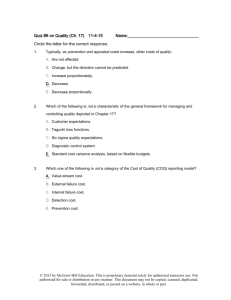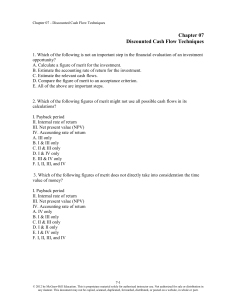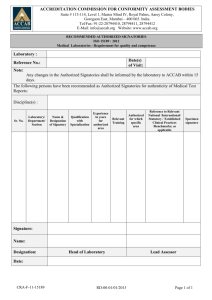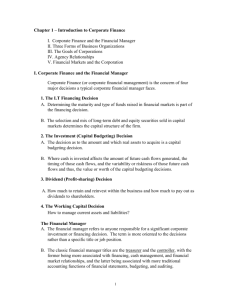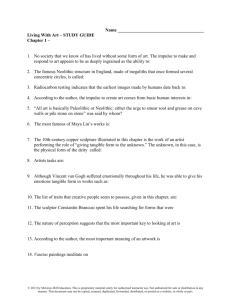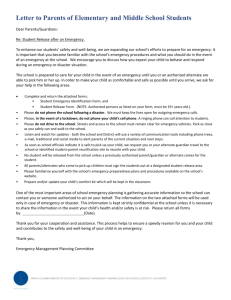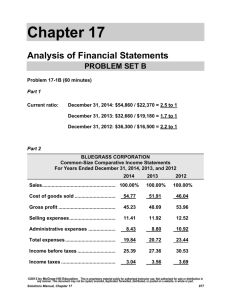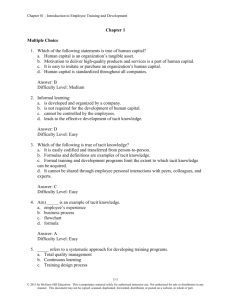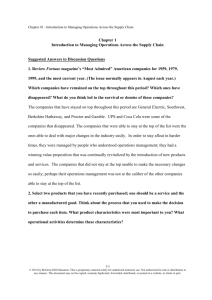Chapter 1 Introduction to Corporate Finance
advertisement
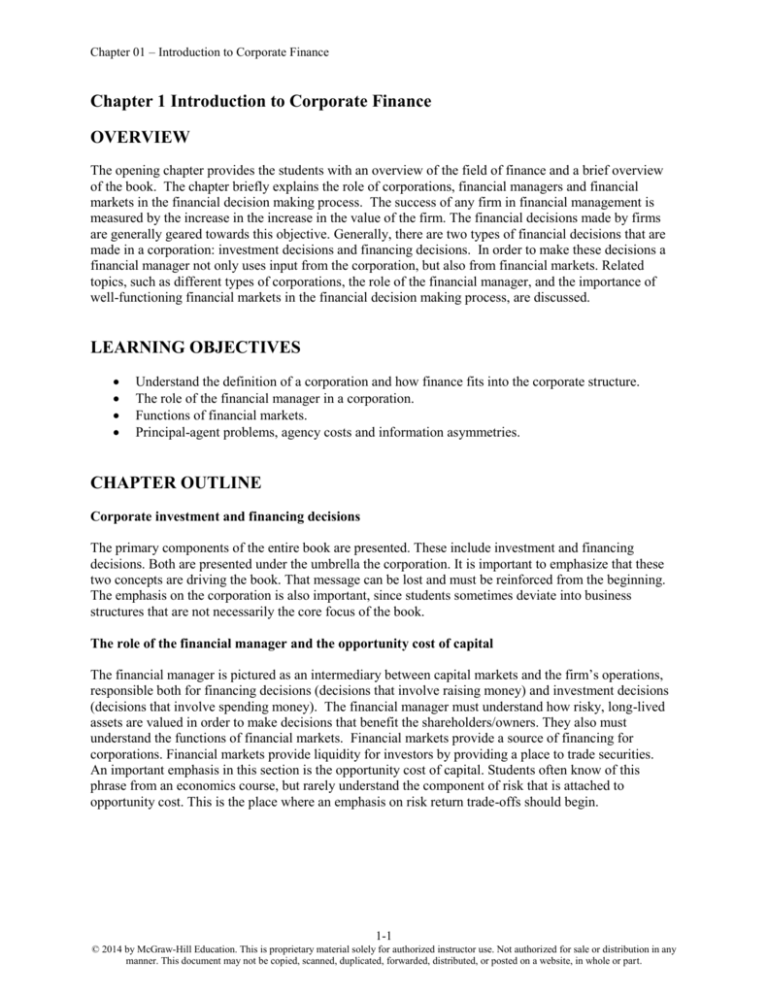
Chapter 01 – Introduction to Corporate Finance Chapter 1 Introduction to Corporate Finance OVERVIEW The opening chapter provides the students with an overview of the field of finance and a brief overview of the book. The chapter briefly explains the role of corporations, financial managers and financial markets in the financial decision making process. The success of any firm in financial management is measured by the increase in the increase in the value of the firm. The financial decisions made by firms are generally geared towards this objective. Generally, there are two types of financial decisions that are made in a corporation: investment decisions and financing decisions. In order to make these decisions a financial manager not only uses input from the corporation, but also from financial markets. Related topics, such as different types of corporations, the role of the financial manager, and the importance of well-functioning financial markets in the financial decision making process, are discussed. LEARNING OBJECTIVES Understand the definition of a corporation and how finance fits into the corporate structure. The role of the financial manager in a corporation. Functions of financial markets. Principal-agent problems, agency costs and information asymmetries. CHAPTER OUTLINE Corporate investment and financing decisions The primary components of the entire book are presented. These include investment and financing decisions. Both are presented under the umbrella the corporation. It is important to emphasize that these two concepts are driving the book. That message can be lost and must be reinforced from the beginning. The emphasis on the corporation is also important, since students sometimes deviate into business structures that are not necessarily the core focus of the book. The role of the financial manager and the opportunity cost of capital The financial manager is pictured as an intermediary between capital markets and the firm’s operations, responsible both for financing decisions (decisions that involve raising money) and investment decisions (decisions that involve spending money). The financial manager must understand how risky, long-lived assets are valued in order to make decisions that benefit the shareholders/owners. They also must understand the functions of financial markets. Financial markets provide a source of financing for corporations. Financial markets provide liquidity for investors by providing a place to trade securities. An important emphasis in this section is the opportunity cost of capital. Students often know of this phrase from an economics course, but rarely understand the component of risk that is attached to opportunity cost. This is the place where an emphasis on risk return trade-offs should begin. 1-1 © 2014 by McGraw-Hill Education. This is proprietary material solely for authorized instructor use. Not authorized for sale or distribution in any manner. This document may not be copied, scanned, duplicated, forwarded, distributed, or posted on a website, in whole or part. Chapter 01 – Introduction to Corporate Finance Goals of the corporation Value maximization is presented as a traditional concept. It is immediately modified to incorporate modern thought on the topic. This expands the goal from simply value maximization to include other components, such as ethics and stakeholders. The section does not attempt to define the goal of the corporation as etched in stone. Given the graduate nature of the text, the topic is presented in a Socratic method and the student is left to ponder the issues raised by ethics, stakeholders and other issues which impact value creation. Agency problems and corporate governance The separation of ownership and management is an important characteristic of the corporation. In the ideal case, this enables the managers to make decisions without worrying about owners’ preferences. It has its share of advantages and disadvantages. This gives rise to principal-agent problems and agency costs. These concepts are discussed in this section. Information asymmetries are major barriers to resolving principal-agent problems facing corporations. The topic of corporate governance is introduced and should be supplemented by current events. The mortgage crisis is noted as one such example. Topics covered in this book An overview of the topics covered in the book is provided. TEACHING TIPS FOR POWER POINT SLIDES Slide 1 - Title slide Slide 2 This slide is merely an overview of the upcoming topics. There is no need to spend too much time here, other than to explain that each of these topics are related to the bigger picture of investments and financing. The relationship to investments and financing should be restated many times during the chapter and even the entire course. Try to cite examples of both real and financial assets. It is often a good idea to identify a student who likes to participate and ask them what kind of business they want to start. Use the student’s business idea to create actual examples. If, for example, the student wants to start a pie baking business you can use the oven, building, and other equipment as real assets. Assume the student raised money via a loan from a bank and an equity investment from family members. These can be cited as financial assets. Slide 3 Continue the example provided in the previous slide and begin to identify the relationship between investment and financing decisions. Using the pie baking example, or whichever one you develop in 1-2 © 2014 by McGraw-Hill Education. This is proprietary material solely for authorized instructor use. Not authorized for sale or distribution in any manner. This document may not be copied, scanned, duplicated, forwarded, distributed, or posted on a website, in whole or part. Chapter 01 – Introduction to Corporate Finance class, to draw the students into the world of financing terminology by connecting the dots between the steps in starting the pie business and the theoretical concepts in finance. Slide 4 This is where you begin the process of introducing more abstract concepts and formal terminology. CAPEX is a first step in showing the students terms commonly used in the profession. This moves the students away from the big picture of investments and into the more specific finance phrase of capital budgeting. If the example presented is too abstract for the students, return to the example used earlier. As with a pie baking company, point out the difference between investing in more ovens versus something abstract like the expanse of experimenting with a new recipe or expanding your business by purchasing a brand name pie company Slide 5 This table is taken directly from the book and shows examples of investment and financing decisions. It is highly encouraged to take examples for the current news and add them as topics of discussion in class. Students related much better when they can reference an event for which they are familiar. Slide 6 This slide explains corporations and the concept of limited liability. Most students will already be familiar with these concepts. Slide 7 Explain the critical role of the financial manager in obtaining funds from financial markets to fulfill the needs of the firm. Be certain to provide the big picture. Explain the cash flows shown in the slide. Explain how cash is generated from operations. Explain how this slide helps in understanding the role of the financial manager. The financial manager must learn to value real and financial assets. The financial manager must understand how financial markets work, for it is there that value is ultimately determined. Also explain the cash flow cycle as given in the diagram. Slide 8 Begin this section with a review of the traditional role of the firm in maximizing the value of stockholders. Spend time pointing out the role and rights of owners of a company to have their goals achieved. It is important to make sure students know the link between ownership of the company and the legitimate desire to maximize stock price. Slide 9 Leap from the concept of maximizing stock price to the concept of how it is done. Point out that the natural tendency to achieve high profits may not necessarily accomplish this task. Long term versus short term profits can be introduced and maybe even a discussion of the short term mindset of the capital markets. 1-3 © 2014 by McGraw-Hill Education. This is proprietary material solely for authorized instructor use. Not authorized for sale or distribution in any manner. This document may not be copied, scanned, duplicated, forwarded, distributed, or posted on a website, in whole or part. Chapter 01 – Introduction to Corporate Finance Slide 10 An excellent follow up to the debate between shareholders and stakeholders is the debate between shareholders and managers. Here it is worth noting the source of true power. In fact, it is important to highlight the fact that owners of a public corporation have very little power relative to managers. Examples of state corporate law can be presented to show the limited influence shareholders have over managers. Slide 11 Here is an important concept check. While not much is written on this slide, take time to draw out the student’s understanding of opportunity cost from their economics course. Some will refer to it as what an investor gives up. Alert students will define it as the value of the next best alternative. Take that definition and explain to them that in the world of finance we add a vital few words, “…at the same level of risk.” If you have an example of how companies you know use different hurdle rates, or examples where companies improperly only use one rate for every decision, cite these as dos and don’ts. Slide 12 Taken directly from the book, emphasize the decision managers must make. This shows the flow of cash as determined by the financial manager. Continue to point out that this is a capital budgeting or investment decision. That theme was introduced earlier and should be constantly reinforced. Slide 13 This slide is more of a summary slide to bring the prior discussion back into focus. It is easy to get distracted with details. This is chance to remind everyone the issue being discussed and the core topic of stakeholders. Slide 14 Explain the concept of separation of ownership and management. Discuss advantages and disadvantages this has, the potential for conflict of interests between shareholders and managers. Explain agency costs, principal-agent problems and information asymmetries. Slide 15 Not only do managers not necessarily respond to the needs of shareholders, the owners incur costs related to protecting their interests. Plenty of current news stories exist to illustrate this point. Slide 16 Now we begin talking about how to force mangers to focus on value creation. We can begin with some theoretical concepts and go over why the managers are not always looking out for th interest of the shareholders. Review the financial incentives that exist. 1-4 © 2014 by McGraw-Hill Education. This is proprietary material solely for authorized instructor use. Not authorized for sale or distribution in any manner. This document may not be copied, scanned, duplicated, forwarded, distributed, or posted on a website, in whole or part. Chapter 01 – Introduction to Corporate Finance KEY TERMS AND CONCEPTS Investment, financing, corporations, limited liability, board of directors, separation of ownership and management, chief financial officer (CFO), treasurer, controller, principal-agent problems, agency costs, information asymmetry, opportunity cost, stakeholder, shareholder, real assets, intangible assets, governance. CHALLENGE AREAS Financing and Investing Corporate governance Agency costs Opportunity cost ADDITIONAL REFERENCES Allen, Franklin, James McAndrews, and Philip Strahan. “E-Finance: An Introduction” Working Paper 0136, Financial Institutions Center, The Wharton School, University of Pennsylvania. October 2001. Core, J.E., W.R. Guay, and D.F. Larcker. “Executive Equity Compensation and Incentives: A Survey,” Federal Reserve Bank of New York Economic Policy Review, 9 (April 2003), pp. 27-50. Gompers, P.A., J.L. Ishii, and A. Metrick. “Corporate Governance and Equity Prices” Quarterly Journal of Economics, 118(1), February 2003, pp. 107-155. L. Guiso, L. Zingales, and P. Sapienza, “Trusting the Stock Market,” Journal of Finance 63 (December 2008), pp. 2557–600. Mackie-Mason, J.K., and R.H. Gordon. “How Much Do Taxes Discourage Incorporation?” Journal of Finance, (June 1997). Rappaport, A. “New thinking on how to link executive pay with performance.” Harvard Business Review, March-April 1999, 91-104. WEB LINKS www.mcgraw-hill.co.uk/textbooks/brealey www.corpgov.net www.thecorporatelibrary.com www.riskmetrics.com www.microsoft.com www.sony.net www.nestle.com www.ge.com www.ft.com www.economist.com www.businessweek.com 1-5 © 2014 by McGraw-Hill Education. This is proprietary material solely for authorized instructor use. Not authorized for sale or distribution in any manner. This document may not be copied, scanned, duplicated, forwarded, distributed, or posted on a website, in whole or part. Chapter 01 – Introduction to Corporate Finance www.forbes.com www.fortune.com/fortune www.cfo.com ADDITIONAL INTERNET ACTIVITIES Visit http://finance.wharton.upenn.edu/~allenf/download/Vita/e-finance.pdf Read the article “E-Finance: An Introduction.” 1-6 © 2014 by McGraw-Hill Education. This is proprietary material solely for authorized instructor use. Not authorized for sale or distribution in any manner. This document may not be copied, scanned, duplicated, forwarded, distributed, or posted on a website, in whole or part.
